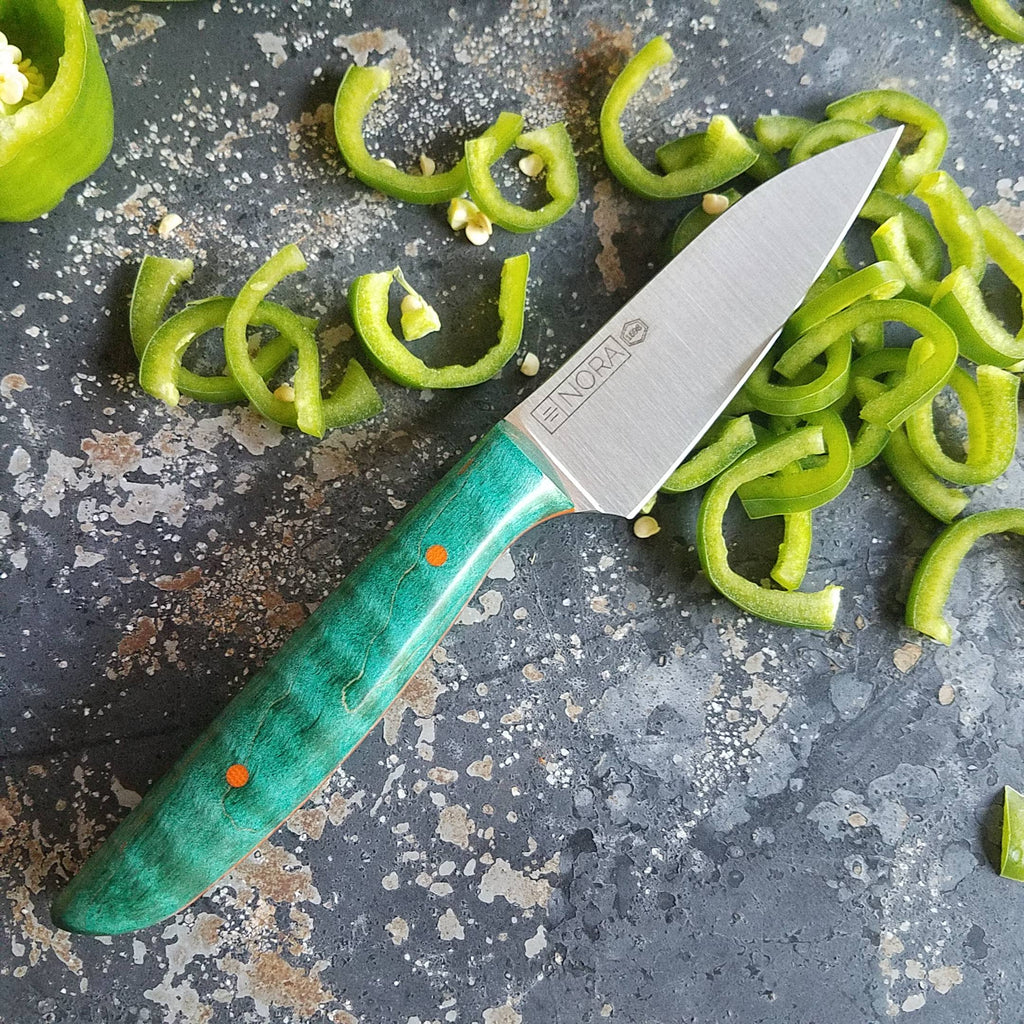
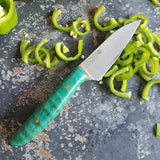
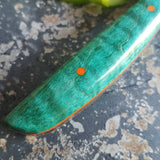
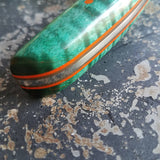
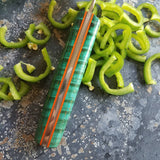
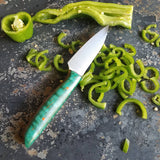
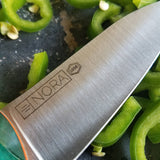
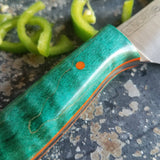
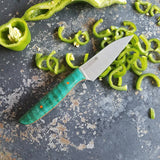
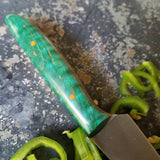
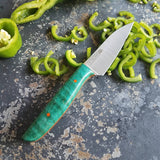
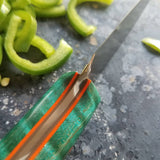
NORA #1698 - 3.5" Paring - Dyed Blue Mango
$ 221.35
KNIFE HIGHLIGHTS
- Blade Type: Paring
- Blade Length: 3.5 Inches
- Total Length: 8 Inches
- Handle Style: Western | Right or Left Hand Use
- Steel: AEB-L Stainless Steel
- Handle Materials: Stabilized and Dyed (teal blue) curly mango wood, orange G10 liners and pins, tan brown G10 liners
- Rockwell Hardness: 61 HRC
- Grind Type: Full Flat Hybrid
- This Blade is Ground...
- Thin for Performance (Best performance, but delicate)
- Thick for Durability (tough, built to last for heavy wear-n-tear)
- >>> Mid-Range with Special Geometry (ground for food release and glide but blade is kept slightly thicker for durability)
- This Knife Feels...
- Heavy in Hand (hefty, durable)
- Light (nimble, maneuverable)
- >>>Not too heavy, not too light (Switzerland)
GENERAL USES OF THIS KNIFE
PARING KNIFE
The paring knife is often overlooked but the truth is it is one of the single most-used knives in the kitchen. It is also unique with respect to where it is used...not just on a cutting board but also in hand.
With this in mind, we redesigned our paring knife to have a smaller, more nimble handle that feels great in hand and gives its user a wide amount of maneuverability. This knife works wonderfully for small tasks that are easier completed by using the knife in-hand, such as hulling a strawberry, paring fruit, or deveining shrimp.
HANDLE DESIGN & MATERIALS:
Every one of our knives is handmade, numbered and unique. This NORA knife has been handled with a beautiful piece of curly mango wood that has been both dyed and stabilized. We let the wood shine on this one and kept the design fairly simple. The only pop of color comes in the form of orange G10 pins and liners. These give just a little contrast and the brown in the liners help balance the bold with more subtle colors. It's a peppy little paring and we love how it came out.
Wood stabilization is an added feature that we offer with our knives. Wood that is stabilized has been injected with a clear acrylic resin under a vacuum process. Stabilization helps to minimize, if not eliminate, any cracking, warping, shrinkage and/or expanding of the material. Stabilized wood will not absorb water and is generally impervious to oils. The process helps to ensure your knife has a long lifespan in the kitchen.
STEEL INFORMATION:
AEB-L STAINLESS STEEL
This knife blade is composed of AEB-L stainless steel which is a high-quality Swedish metal, originally developed for razor blades. Recently, steel suppliers have made this steel available in thicker sheets and it has proven to be an excellent adaptation for the cutlery industry.
AEB-L has a beautiful balance of carbon and chromium and, with proper heat treatment, this steel produces both a very fine edge as well as excellent toughness and edge stability. The fine grain structure also makes this steel very easy to sharpen. We believe it is one of the finest stainless steels available on the market today for use with kitchen knives.
As a side note, there are two things we like to mention about this steel:
1.) This steel responds beautifully to honing and if the knife is honed regularly it should need infrequent sharpening.
2.) AEB-L is a stainless steel but just barely. The higher carbon content in this stainless is what allows it to get a fine edge and higher hardness than other stainless steels but it also has a tendency to sometimes form very fine rust spots on the blade. If this happens, these are easily removed with a green scotch brite pad and usually the rough end of a kitchen sponge will also do the trick.
